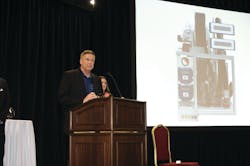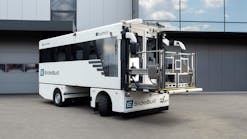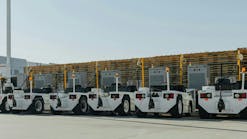Rampmaster’s Engine Management System: 2014 Ground Support Product Leader
This year’s Ground Support Product Leader award-winner is, at its most basic, a grey plastic box that isn’t much bigger than a man’s hand.
Visitors to Rampmaster’s booth at AviationPros LIVE trade show held earlier this month in Las Vegas might have paid more attention to the flow control and bypass servos, Venturis, primary valves, secondary valves, versa valves, pilot valves, regulators and sense lines also on display alongside this relatively small plastic box.
All those mechanical parts and pieces, however, are exactly what Rampmaster’s patented Engine Management (Flow Control) System does away with and, in process, saves money on fuel and wear and tear on Rampmaster refueling trucks.
The typical refueler truck operator has to run the engine at high RPMs to pump the fuel while a bevy of mechanical devices and sensors regulated pressure to the wing. The programmed circuitry hidden inside the grey plastic box takes care of much of this operation and can produce the same pressure with the less power.
“EMS gives operators the ability to control the flow of fuel in the fuel truck using the engine and eliminating the traditional parts we used to have in the system,” says Kevin Ward, the company’s director of marketing and sales. “By doing away with these we’ve done away with anything that would restrict the flow of the fuel.”
As a result, the truck can deliver the optimum flow of fuel by running just off idle.
“Eliminating the restrictions of delivering fuel is the key,” Ward says. Eliminating the restrictions means eliminating the need to raise the RPM of the truck’s engine.
“It adds up to a big savings on fuel used in operations day to day, plus it adds to the longevity to the engine and drive train by not revving the RPMs to deliver fuel.”
The technology was developed by Owen Watkins, Rampmaster's chief operating officer while he served as vice president of engineering and production.
"No longer does a fuel truck have to waste engine fuel by moving fuel around in a bypass loop while the engine stays at a high RPM," Owen explains. "EMS allows the engine RPM to vary up and down depending on what the aircraft needs are."
While the product’s innovation certainly went a long way toward earning their year’s Ground Support Leader award, Rampmaster sealed the deal when it took the added measure of obtaining third-party verification that the product did all that it promised.
THIRD-PARTY TESTS
After introducing the EMS two years ago at our trade show and other industry events, the company hired West Virginia University's Center for Alternative Fuels, Engines and Emissions to put the product through a series of tests.
CAFEE is a nonprofit research center well-known for its research measuring exhaust emissions of both conventional and alternative-fueled engines. The center has conducted hundreds of research projects for fuel suppliers such as BP, engine manufacturers such as Cummins, vehicle manufacturers such as Ford and GM, federal agencies such as the Department of Energy and the Environmental Protection Agency and many other similar state agencies throughout the country.
In 2012, CAFEE traveled on-site to evaluate fuel consumption rates and emissions from three aircraft refueling vehicles at varying refueling rates:
- A 2005 5,000-gallon truck made by a Rampmaster competitor.
- A 2011 5,000-gallon Freightliner with a Rampmaster EMS.
- A 2011 10,000-gallon Crane Carrier Company vehicle, evaluated with and without the Rampmaster EMS.
Once the tests were finalized, the Rampmaster EMS did better than the company had hoped.
- The Rampmaster EMS, when employed on the 2011 CCC chassis, resulted in significant reductions in fuel consumption – from 45 percent up to 78 percent – per 10,000 gallons delivered at all refueling rates.
- A comparison of fuel consumption rates between the competitor's truck and the 2011 Freightliner chassis equipped with the Rampmaster EMS also showed up to 43 percent reduction in fuel consumption per 10,000 gallons delivered at all refueling rates.
In addition, according to the CAFEE report, "since carbon dioxide emissions are directly correlated to fuel consumption, any reduction in fuel consumption or increase in fuel economy will result in a corresponding decrease in greenhouse gas emissions."
"The savings in both diesel fuel and carbon emissions are unprecedented in the industry," said Owen, "and we're proud to be the company that is delivering this game-changing innovation to the market."






